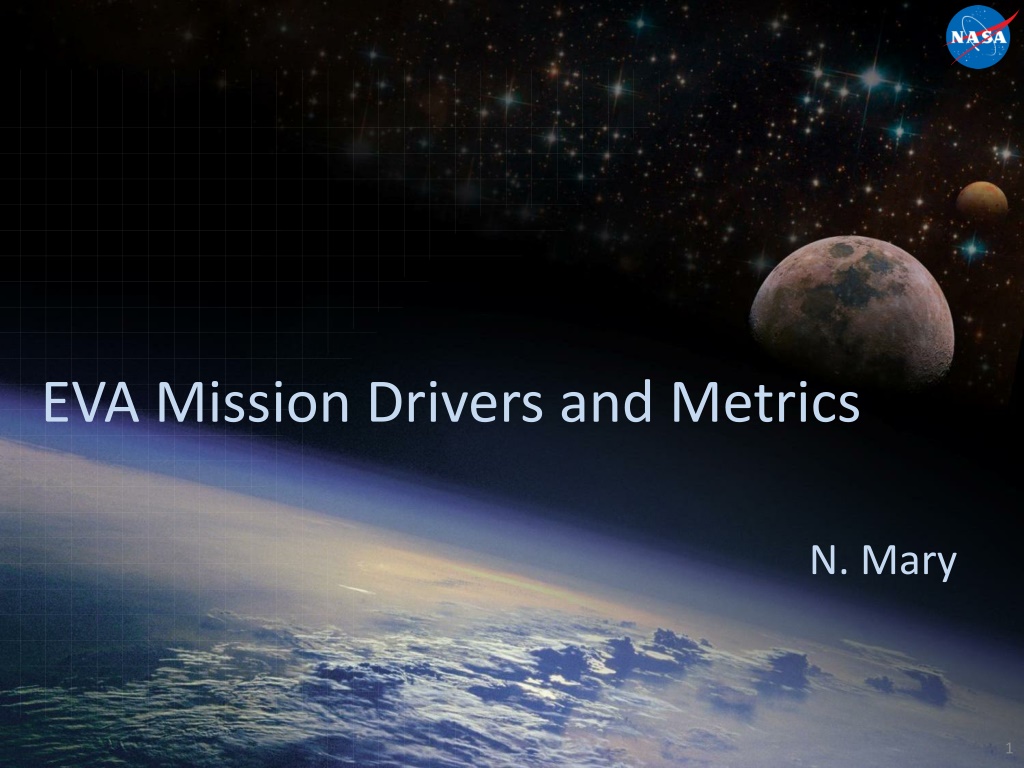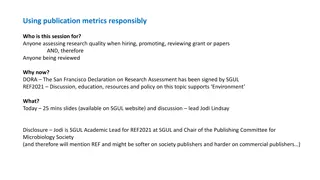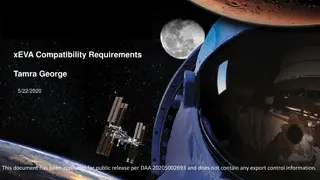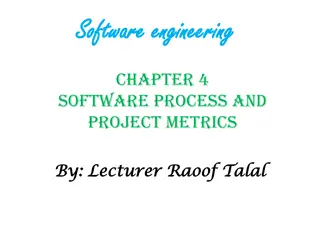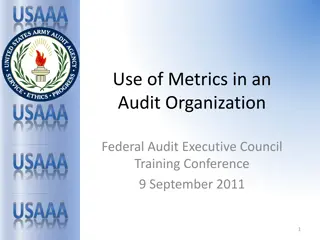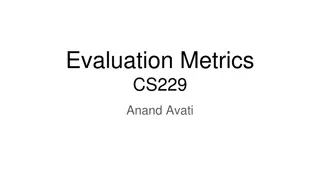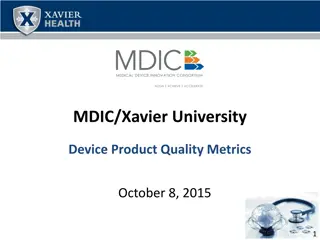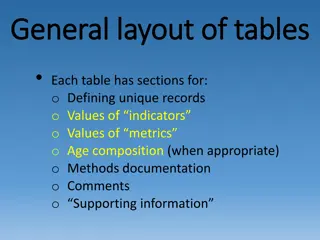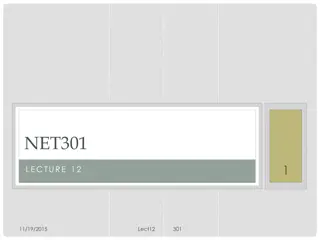Understanding EVA Mission Drivers and Metrics
Decomposing Design Reference Mission operational concepts helps identify EVA mission drivers, necessary system capabilities, and gaps. Factors like mission purpose, duration, suit maintenance, environment, and communication delays heavily influence mission success. Purpose, types of EVAs (contingency vs. nominal), and mission duration and vehicle architecture all play crucial roles in determining the success and functionality of extravehicular activities. Suit architecture and mass/volume of logistics are directly impacted by mission duration, number of EVAs, and ingress/egress methods.
Download Presentation

Please find below an Image/Link to download the presentation.
The content on the website is provided AS IS for your information and personal use only. It may not be sold, licensed, or shared on other websites without obtaining consent from the author. Download presentation by click this link. If you encounter any issues during the download, it is possible that the publisher has removed the file from their server.
E N D
Presentation Transcript
EVA Mission Drivers and Metrics N. Mary 1
EVA Mission Drivers Each of the Design Reference Mission (DRMs) Operational Concepts are decomposed to understand the EVA mission drivers and therefore required EVA System capabilities and identification of gaps/needs This allows us to estimate variables needed by the DRM feasibility studies to calculate overall mission metrics such as mass, volume, and power allocations Mission drivers heavily influence EVA System gaps and metrics At a high level mission drivers include such items as: Purpose of the EVAs Mission duration and vehicle architecture Suit maintenance Environment Ingress/egress methods Communication delays 2
Purpose of Typical EVA Contingency Only: Contingency Only EVAs are performed only in case of a significant known or unknown mitigation to risk, typically limited to a small number/duration of EVAs Nominal EVA: Nominal EVAs are planned EVAs for the purposes of maintenance/construction or science/research objectives Maintenance tasks: Planned EVAs used to conduct regular maintenance on any vehicle or habitat; microgravity EVA operations are much the same way as those on ISS Research/Exploration objectives: Planned EVAs that enable exploration, science collection/return, and research instrumentation emplacement; HD video, still shots, voice recording, and timestamps can enhance certain science objectives The Destination Class and whether or not the purpose of the EVA is considered to be Contingency EVA vs. Nominal EVA assist in the determination of the type of suits and life support system options 3
Mission Duration and Vehicle Architecture The Mission Duration and Vehicle Architecture directly influence the mass/volume of logistics, spares, and vehicle interfaces to the suit Depending on the ops con, the number of EVAs during the surface stay directly affects the amount of logistics and spares needed to carry out the mission, some of which may have long periods of dormancy Ingress/egress methods in particular can result in changes to suit architecture and consequently mass, along with impacts to vehicle and consumables mass 4
Suit Maintenance The regular supply of logistics in Low Earth Orbit (LEO) with current human spaceflight ISS missions is fundamentally different from any mission beyond LEO Instead of sending suits back to Earth for suit maintenance, procedures will be performed during the mission with necessity and increasing for longer duration missions Mass/Volume for logistics and spares (dependent on manned pressurized time) Umbilical Interface Panels need to be located where suited crewmember operations occur Environment can also be a factor as the presence of dust increases the need for suit maintenance Abrasion to the suit Dust resistant bearings 5
Environment Radiation environment For long duration missions beyond LEO, EVA durations are short enough that anything beyond radiation monitoring would be insignificant to the crewmembers health and would add mass and mobility challenges beyond any potential health benefit Dust Mitigation/Planetary Protection Lessons learned from Apollo missions Forward and Backward Contamination on Mars Layered engineering and operational defense can include air quality controlled zones in the habitation elements and zones of exclusion from potential areas that may be hazardous to human health Vacuum vs. Atmosphere Unlike the lunar surface mission discussed in the sections above, Martian atmosphere has sufficient properties to inhibit vacuum-dependent thermal management schemes and CO2 removal methods Gravity Mobility and Center of Gravity are highly dependent on suit design Partial gravity fatigue could also drive crewmembers to perform shorter EVAs or lower on- back mass Decompression Sickness (DCS) studies show differences that need to be further understood 6
Ingress/Egress Methods Frequency/duration of EVAs and ingress/egress methods also drive changes to the ops con and suit architecture Relative to current ISS operations of about 8 EVAs/year, high frequency EVA capability with dust mitigation on a surface mission trades well for an overall surface architecture pressurized roving capability Prebreathe durations can vary quite a bit between conventional ISS EVAs and other ingress/egress methods Prebreathe duration exceeding the actual EVA duration decreases work efficiency Suit interfaces to ingress/egress methods drive suit mass Depressurizable volume and number of EVAs affects consumables, power, mass The number of EVAs per DRM drive a logistics and sparing philosophy If the amount of EVA hours exceeds the lifetime of the components of the suit, replacement logistics must be sent Depending on failure modes and risk, extra spares beyond what is necessary to complete the mission must be sent 7
Communications Delays Near constant communications with current human spaceflight ISS missions is a fundamental difference from any mission beyond Cis-Lunar The communications delay between the ground and the spacecraft increases to an average of 20 minute round trip delays on Mars A flexible operational paradigm shift is needed so that the crew can make changes to their activities in near real-time (greater autonomy) to satisfy science and maintenance objectives as human spaceflight travels farther from LEO Robust EVA caution and warning and information systems can assist crewmembers in making real-time decisions without heavily relying on ground teams Some operational concepts also include IVA crewmembers and robotics assisting EVA crewmembers 8
Metric Estimates Mission Drivers influence the identification and understanding of the EVA gaps, inputs into overall mission architecture feasibility studies, and the design and metrics of the EVA System (such as component mass, on-back mass, and EVA System mass) Currently, the EVA Office assesses these metrics using a spreadsheet bottoms-up method primarily based on current ISS Extravehicular Mobility Unit masses for the many different DRM feasibility studies It is the EVA Office s goal to increase both the speed and quality of EVA System estimates for future spaceflight architectures through use of a Parametric Estimation Tool We ve identified the relevant variables required to cross-compare historic actuals and estimates of novel systems and are in the process of documenting such a process Next step: developing a tool to bucket heritage and feasibility studies into data clusters A Parametric Estimation Tool would be used to drive quality estimates useful for future mission feasibility assessments Notional DRM Clusters (numbers are representative) 9
Implementation A key element within these paradigms is simply why and how will you use the system at the destination? A huge driver in human spaceflight and exploration is research and science Operations, Mobility, Information, Tools LUNAR SCIENCE EVA OPS DURING APOLLO 17 10
BACKUP 11
EVA Mission Drivers to Metrics Based on each of the DRMs and EVA Destination Classes, a set of parameters can be established from the concept of operations that allows us to determine metrics, such as mass, volume, and power The following is an example for ISS: 12
